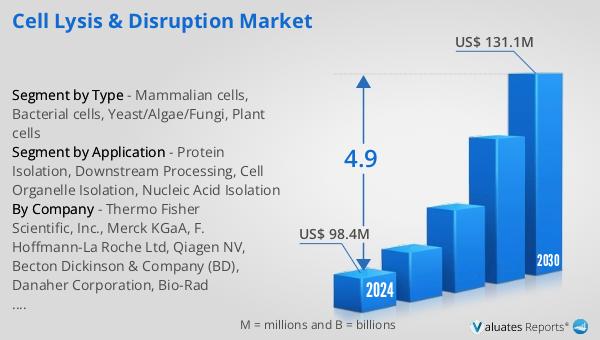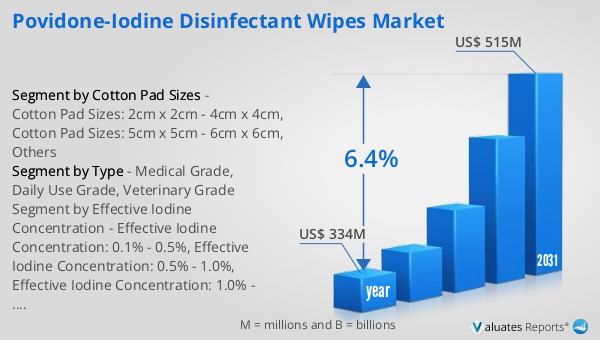What is Global Cell Lysis & Disruption Market?
The Global Cell Lysis & Disruption Market is a specialized segment within the broader biotechnology and life sciences industry. This market focuses on the development and sale of technologies and products designed to break open cells, a process known as cell lysis, to extract valuable biological molecules such as proteins, nucleic acids, and other cellular components. Cell lysis is a critical step in many laboratory and industrial processes, including research, diagnostics, and biomanufacturing. The market encompasses a variety of methods and tools, including mechanical, chemical, and enzymatic techniques, each suited to different types of cells and applications. As research and development in biotechnology continue to expand, the demand for efficient and effective cell lysis and disruption technologies is expected to grow. This market is driven by advancements in molecular biology, increasing investments in research and development, and the rising need for personalized medicine and biopharmaceuticals. Companies operating in this space are continually innovating to provide more efficient, cost-effective, and user-friendly solutions to meet the diverse needs of researchers and manufacturers worldwide. The market's growth is also supported by the increasing prevalence of chronic diseases, which drives the demand for new and improved therapeutic solutions.

Mammalian cells, Bacterial cells, Yeast/Algae/Fungi, Plant cells in the Global Cell Lysis & Disruption Market:
Mammalian cells, bacterial cells, yeast/algae/fungi, and plant cells represent the diverse range of cell types targeted by the Global Cell Lysis & Disruption Market. Each type of cell presents unique challenges and opportunities for lysis and disruption, necessitating specialized approaches and technologies. Mammalian cells, for instance, are complex and delicate, often requiring gentle lysis methods to preserve the integrity of proteins and other cellular components. Techniques such as osmotic lysis, sonication, and the use of mild detergents are commonly employed to achieve effective disruption without damaging the cell's valuable contents. Bacterial cells, on the other hand, have a rigid cell wall that requires more robust methods for lysis. Mechanical disruption techniques like bead milling or high-pressure homogenization are often used, along with enzymatic treatments that target the peptidoglycan layer of the cell wall. Yeast, algae, and fungi present another set of challenges due to their tough cell walls, which are often composed of chitin or cellulose. Enzymatic lysis using specific enzymes like lyticase or cellulase is a common approach, sometimes combined with mechanical methods to enhance efficiency. Plant cells, with their rigid cellulose walls, also require specialized techniques for effective lysis. Methods such as grinding with liquid nitrogen, enzymatic digestion, or high-pressure homogenization are frequently employed. The choice of lysis method depends on the specific application and the desired outcome, whether it be the extraction of proteins, nucleic acids, or other cellular components. The Global Cell Lysis & Disruption Market is continually evolving to address the unique needs of these diverse cell types, driven by advancements in technology and a deeper understanding of cellular biology. As research in areas such as genomics, proteomics, and metabolomics continues to expand, the demand for efficient and effective cell lysis and disruption technologies is expected to grow, supporting the development of new therapies and diagnostic tools.
Protein Isolation, Downstream Processing, Cell Organelle Isolation, Nucleic Acid Isolation in the Global Cell Lysis & Disruption Market:
The Global Cell Lysis & Disruption Market plays a crucial role in various applications, including protein isolation, downstream processing, cell organelle isolation, and nucleic acid isolation. Protein isolation is a fundamental application, as proteins are essential for numerous biological processes and are often the target of therapeutic and diagnostic research. Efficient cell lysis is critical for releasing proteins from cells while preserving their structure and function. Techniques such as sonication, detergent lysis, and enzymatic digestion are commonly used to achieve this goal. Downstream processing involves the purification and refinement of biological products, and effective cell lysis is a key step in this process. By breaking open cells, valuable biomolecules can be extracted and further processed to produce pharmaceuticals, enzymes, and other bioproducts. Cell organelle isolation is another important application, as it allows researchers to study specific components of the cell, such as mitochondria, nuclei, or lysosomes, in detail. This requires precise lysis techniques that can selectively disrupt the cell membrane while preserving the integrity of the organelles. Nucleic acid isolation, including DNA and RNA extraction, is a critical step in many molecular biology applications, such as sequencing, cloning, and gene expression analysis. Effective cell lysis is essential for releasing nucleic acids from cells while minimizing degradation and contamination. The Global Cell Lysis & Disruption Market provides a range of tools and technologies to support these applications, enabling researchers and manufacturers to achieve their goals efficiently and effectively. As the demand for personalized medicine and biopharmaceuticals continues to grow, the importance of efficient cell lysis and disruption technologies is expected to increase, driving innovation and growth in this market.
Global Cell Lysis & Disruption Market Outlook:
The outlook for the Global Cell Lysis & Disruption Market indicates a promising growth trajectory over the coming years. According to projections, the market is expected to expand from a valuation of $98.4 million in 2024 to $131.1 million by 2030. This growth represents a compound annual growth rate (CAGR) of 4.9% during the forecast period. This upward trend is driven by several factors, including the increasing demand for biopharmaceuticals, advancements in biotechnology, and the growing emphasis on personalized medicine. As research and development activities in the life sciences sector continue to expand, the need for efficient and effective cell lysis and disruption technologies is expected to rise. Companies operating in this market are focusing on innovation and the development of new products to meet the evolving needs of researchers and manufacturers. The market's growth is also supported by the increasing prevalence of chronic diseases, which drives the demand for new and improved therapeutic solutions. As a result, the Global Cell Lysis & Disruption Market is poised for significant growth, offering numerous opportunities for companies and researchers alike.
| Report Metric | Details |
| Report Name | Cell Lysis & Disruption Market |
| Accounted market size in 2024 | US$ 98.4 million |
| Forecasted market size in 2030 | US$ 131.1 million |
| CAGR | 4.9 |
| Base Year | 2024 |
| Forecasted years | 2025 - 2030 |
| Segment by Type |
|
| Segment by Application |
|
| By Region |
|
| By Company | Thermo Fisher Scientific, Inc., Merck KGaA, F. Hoffmann-La Roche Ltd, Qiagen NV, Becton Dickinson & Company (BD), Danaher Corporation, Bio-Rad Laboratories, Inc., Miltenyi Biotec GmbH, Claremont BioSolutions, LLC, Microfluidics International Corporation, Parr Instrument Company, BioVision, Inc., Covaris, Inc., Qsonica LLC |
| Forecast units | USD million in value |
| Report coverage | Revenue and volume forecast, company share, competitive landscape, growth factors and trends |
